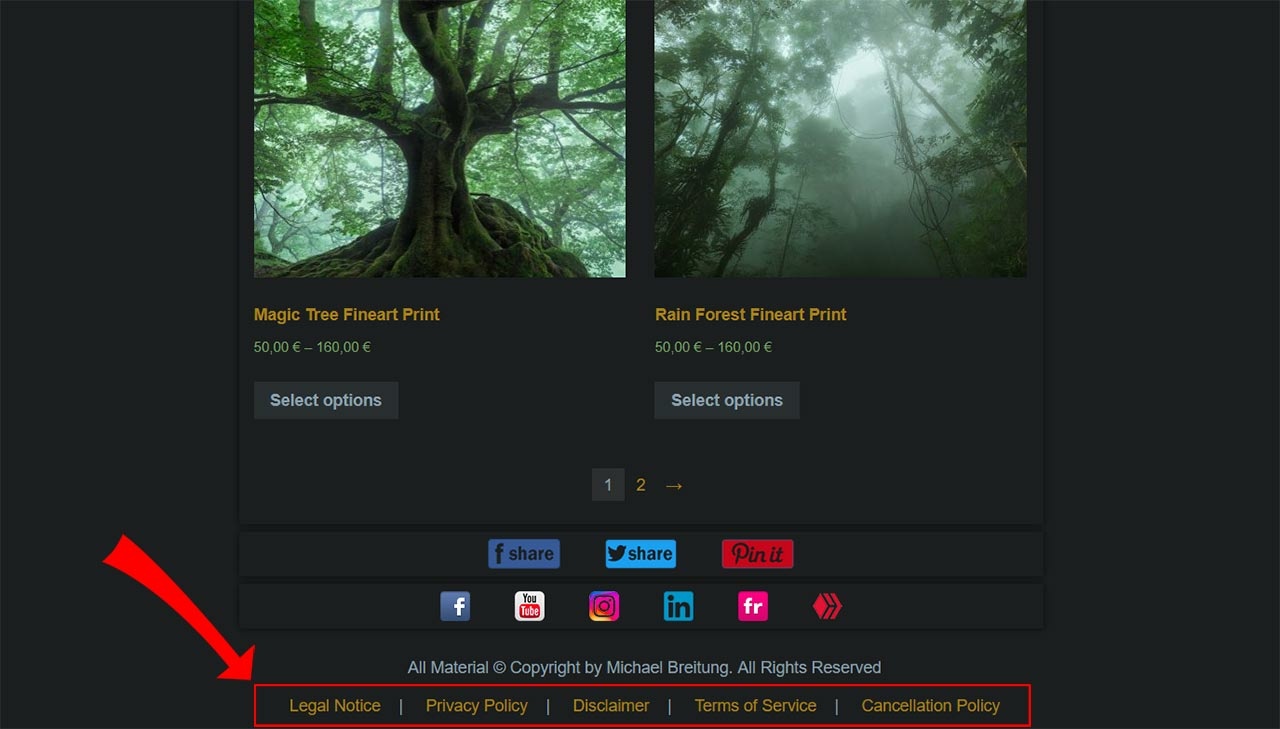There are many ways to sell prints online. In the last article of this series, we already looked at one of them that was free and easy to set up. But it might not be the right way to sell prints professionally. If branding and customer relations are important to you, a customized online store might be a better solution. In this article, I share how to set one up.
First of all, you must decide which platform to use. With services like Squarespace, Smugmug, Photoshelter, and Shopify, to name just a few, it's up to you to pick and choose. But not so quickly. Those platforms are not cheap. If you require e-commerce support, Squarespace, for example, will cost you at least $25 per month plus a 3% fee for every sale you make. If you want options like customizable delivery or discounts, you will pay more than $50. With Smugmug and Shopify, you'll pay between $30 and $50. Photoshelter might look a lot cheaper at first glance, but they charge between 8% and 10% transactional fee for every sale you make. So, based on the sales volume, you might pay even more than when using the other platforms.
Contrast those prices with a typical web hosting solution from services like GoDaddy or Ionos, which I use. For around $6, you get a solid base to self-host your e-commerce homepage, with nothing missing but the website itself.
If we do the math and compare this to Squarespace, you save $228 per year compared to their basic e-commerce offering. If you don't plan on changing the look of your homepage every one or two years, which is simple with platforms like Squarespace, this can add up.
Now, you know your budget for paying somebody to create a homepage for you or buying a WordPress theme plus a few plugins and hooking everything up yourself. It's certainly not for everyone, and you might value your time much higher than those $228 per year you can save by self-hosting. But again, as soon as you need more features, the $228 can quickly turn into $500 or more.
Below, I will first go through a general checklist of things you need to create an online print store. This checklist will be relevant for both self-hosted websites and when using the mentioned platforms.
Afterward, I show you an example of how to self-host an e-commerce website.
E-Commerce Checklist
Before I moved from using Redbubble to a fully customized e-commerce solution, there were some things I had to do.
Privacy Policy
I already had a privacy policy long before starting the transition because I live in the EU. But even if you don't, if you want to sell your prints to European customers, you better include a privacy policy on your homepage.
To fulfill orders, you must process customer data and most likely pass it on to a print provider unless you print yourself. Such uses must be transparent to your customers. And while you're at it, don't forget to add a legal notice and disclaimer to your homepage.
Terms of Service and Cancellation Policy
Those two are required once you turn your homepage into an e-commerce platform. And it's a pain to create those. You could use one of the many available generators and templates, for example, Shopify's terms of service template. But those are very generic, and you'll spend much time adjusting them.
The alternative is to use an external service that provides customized legal documents for your website. Here, you can plan another $10 a month for a subscription.
Consent Form
E-commerce solutions usually store information on the customer's device in the form of cookies. You should inform a user of your website about it through a cookie consent form. Those are the annoying popups you see on many websites today.
There are many solutions available which you will find via Google. If you fancy integrating one yourself, I have a tutorial on that topic.
Payment Gateway
How are you planning to charge your customers? If you select one of the mentioned platforms, you must understand which integrations they offer and know you will have to get additional accounts for those.
A typical payment gateway is PayPal. By creating a business account, you can not only use it to accept payment via PayPal itself but also via credit card. Other options are Stripe, which I used for several years to offer credit card payments to people buying my tutorials.
Print Provider
Setting up an e-commerce platform is one thing, but getting the goods produced and delivered to your customers is something you must handle separately. If you plan on printing yourself, you only have to figure out the packaging and logistics for shipping. But even if you don't want to print, there are solutions.
One is to automate the whole process by integrating a service like CreativeHub. They offer integrations for Squarespace, Woocommerce, Shopify, and some others. Printing and drop-shipping are done by thePrintSpace, the company behind CreativeHub. You can even use them to sell limited edition prints, and their free tier allows you to store up to 30 GB of data. If you expect a high sales volume, then such an automated service might be a requirement for you. It's something to consider when selecting your e-commerce platform because not all allow its integration.
Alternatively, you will have to do some manual order processing. Once an order arrives in your system, you can forward it to the print provider of your choice for fulfillment. It is the option I've now chosen for my shop. I use Whitewall for that. If you live in the US, you'd use their US website to order customer prints. If you live in the EU, you can use their EU website.
Tax
An important part of selling your art is to consider tax requirements. The regulations are different based on the location of your business and the types of sales you make. Ask yourself questions like:
- Do you want to sell internationally? If so, which countries do you want to target?
- Do you want to only sell to private customers (B2C) or as well to other businesses (B2B)?
- What volume of sales do you expect over one year?
The answers to those questions will, for example, tell you, if you need a VAT id. Even if you fall under special regulations in your own country and are not required to get one, selling internationally might still require it in some cases. An excellent resource to educate yourself on this topic is Quaderno. In addition to that, you might also want to seek professional counsel.
Setup
Once you selected a platform and went through the checklist, you're ready to set up your shop. And as I already mentioned, I will go through the self-hosting option, for which I use WooCommerce. If you decide to also do it like this, you should either have some basic knowledge about web development or get help. Otherwise, you can end up with a slow website that might not look or work as you want.
WordPress
Step one is to install WordPress on your server. Download the latest version from here and follow the instructions on how to install WordPress. If this part already bothers you, hire a web developer or use one of the platforms mentioned in the beginning, and don't self-host.
WooCommerce
WooCommerce is open-source and free. It's available as a plugin for WordPress, and installing it can be done via the WordPress dashboard. It offers a lot of settings, and you should take your time to study and configure each one of them. You would do the same with a platform like Shopify.
Some essential parts of the setup are, linking your legal documents, configuring emails, setting up shipping zones, creating print variations, selecting prices, and adding a payment gateway. For PayPal, you can install another plugin and connect it to your business account.
Test Product
Once the basic setup is complete, test it by creating a first product and making a test purchase to ensure everything works smoothly. To not spend too much on this test product, use a dummy that costs just one dollar. Such a test order should trigger emails to your business and the customer's mail address and initiate the money transfer.
Theming
To adjust the look of a WordPress homepage, you need custom themes. If you don't want to develop one yourself or pay a web developer for it, you can buy one online. There are countless photography-specific themes available, starting at around $50 for an e-commerce-enabled theme. The alternative that involves some more work is using a builder like Oxygen. Unfortunately, it will soon move to a subscription-based license, taking away the appeal of using it for a single website.
I did the whole theming myself, and I have to say, it's a bit painful. If you are not careful and don't know what you are doing, you can end up with an unmaintainable mess. Even some of the commercial themes look a bit messy.
Print Mockups
If you made it this far, it's finally time to turn your photos into products. To compete with other stores, you should create mockups of how your photos will look as wall art in different environments. An affordable resource for such mockups is freepik. It's a subscription-based service through which you can download PSD files for different room settings.
And don't worry about having to pay a continuous subscription. You get a license file for each download you make during your subscription allowing you to use the images even after you cancel it.
Descriptions
If you spend so much time and effort to set up your storefront, you surely also want people to find it. That's why you have to think about SEO. This way, you make your store discoverable through Google and other search engines. To do so, add tags and custom descriptions to all your products.
It is where ChatGPT and Grammarly are a great help. Use ChatGPT to create a first description, then bring it to Grammarly and refine it. Avoid using the texts from ChatGPT as is. They usually need some attention, and it also doesn't hurt to add a personal note, for example, by sharing behind-the-scenes information.
Conclusion
Creating a personalized print shop that you host yourself takes a significant amount of effort. But once you're finished, the reward is having a storefront over which you have full control. You can even take all your data and head to another provider if new terms or prices are imposed or you are not satisfied with some aspect of the offering. I have done this once in the past.
With platforms like Squarespace, you can't simply migrate your website. But most likely, you don't have to. It's just something to be aware of. And although those platforms offer countless configurations, you can run into limitations if you have special requirements. That's why the final tip I want to give you here is: write down specific requirements for your website and print shop. Take your time for this task, look at similar offerings by other photographers, and figure out what you need. Those requirements will help you not regret your choice of platform later on.









